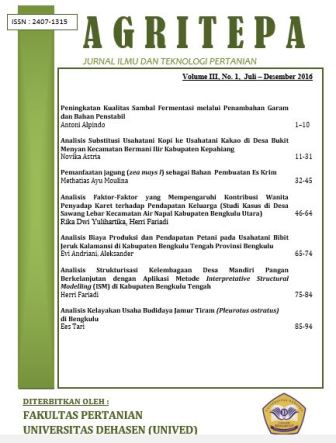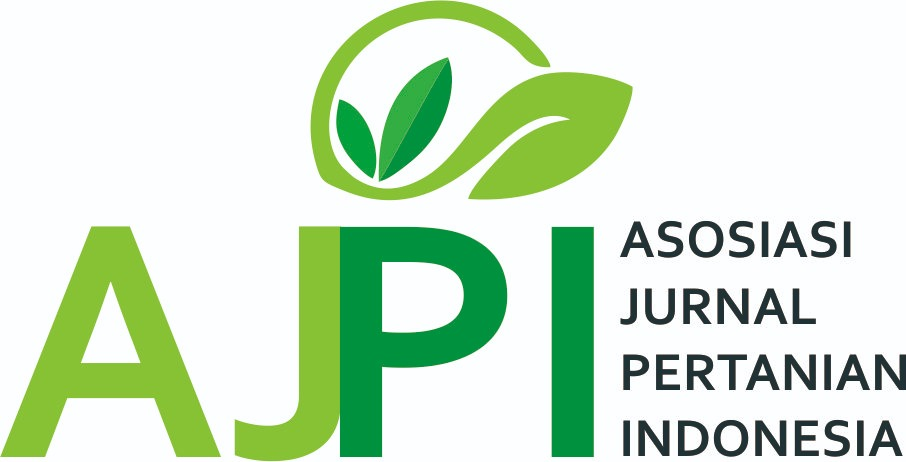Study Of Antioxidant Activity Of Kombucha Beverage: Literature Review
Abstract
Kombucha merupakan minuman yang diperoleh dengan cara fermentasi teh manis menggunakan simbiotik dari bakteri dan khamir. Jika dibandingkan dengan teh non-fermentasi, kombucha mempunyai kandungan antioksidan yang lebih tinggi karena selama proses fermentasi terjadi pembentukan asam-asam organik yang mengakibatkan terjadinya peningkatan senyawa fenol dan peningkatan aktivitas antioksidan yang ditandai dengan tingginya rasio pengikatan radikal DPPH dan ABTS. Selain itu, kombucha juga dapat menghambat peroksidasi asam linoleat dan mengkelat senyawa logam yang bersifat prooksidan.
Downloads
References
Aidoo, E. (2015). Studies on the cytotoxicity and antioxidant activity of tea kombucha. University of Ghana.
Amarasinghe, H., Weerakkody, N. S., & Waisundara, V. Y. (2018). Evaluation of physicochemical properties and antioxidant activities of kombucha “Tea Fungus” during extended periods of fermentation. Food Science & Nutrition, 6(3), 659–665. https://doi.org/10.1002/fsn3.605
Chakravorty, S., Bhattacharya, S., Chatzinotas, A., Chakraborty, W., Bhattacharya, D., & Gachhui, R. (2016). Kombucha Tea Fermentation: Microbial and Biochemical Dynamics. International Journal of Food Microbiology, 220, 63–72.
Chang, C., & Chen, J. (2004). Study on the protective mechanism of organic acids in human umbilical vein endothelial cells. Acta Nutrimenta Sinica, 260, 280–283.
Chen, C., & Liu, B. Y. (2000). Changes in major components of tea fungus metabolites during prolonged fermentation. Journal of Applied Microbiology, 89(5), 834–839. https://doi.org/10.1046/j.1365-2672.2000.01188.x
Chu, S., & Chen, C. (2006). Effects of origins and Effects of origins and fermentation time on the antioxidant activities of kombucha. Food Chemistry, 98(3), 502–507.
Dipti, P., Yogesh, B., Kain, A. K., Pauline, T., Anju, B., Sairam, M., & Selvamurthy, W. (2003). Lead induced oxidative stress: beneficial effects of Kombucha tea. Biomedical and Environmental Sciences, 16(3), 276–282.
Essawet, N., Cvetkovic, D., Velicanski, A., Canadanovicˇ-Brunet, J., Vulic, J., Maksimovic, V., & Markov, S. (2015). Polyphenols and antioxidant activities of kombucha beverage enriched with coffeeberry extract. C21:399–409. Chem Ind Chem Eng, 21(3), 399–409.
Filippis, F., Troise, A., Vitaglione, P., & Ercolini, D. (2018). Different temperatures select distinctive acetic acid bacteria species and promotes organic acids production during kombucha tea fermentation. Food Microbiol, 73, 11–16.
Fu, C., Yan, F., Cao, Z., Xie, F., & Lin, J. (2014). Antioxidant activities of kombucha prepared from three different substrates and changes in content of probiotics during storage. Food Science and Technology, 34(1), 123–126.
Fu, L., Peng, J., Zhao, S., Zhang, Y., Su, X., & Wang, Y. (2017). Lactic acid bacteria-specific induction of CD4+Foxp3+T cells ameliorates shrimp tropomyosin-induced allergic response in mice via suppression of mTOR signaling. Scientific Reports, 7.
Gaggia, F., Baffoni, L., Galiano, M., Nielsen, D. S., Jakobsen, R. R., & Castro-Mejia, J. L. (2019). Kombucha Beverage from Green, Black and Rooibos Teas: A Comparative Study Looking at Microbiology, Chemistry and Antioxidant Activity. Nutrients, 11(1).
Greenwalt, C., Steinkraus, K., & Ledford, R. (2000). Kombucha, The Fermented Tea: Microbiology, Composition, And Claimed Health Effects. J. Food Prot, 63, 976–981.
Ivanišová, E., Meňhartová, K., Terentjeva, M., Godočíková, L., Árvay, J., & Kačániová, M. (2019). Kombucha tea beverage: Microbiological characteristic, antioxidant activity, and phytochemical composition. Acta Alimentaria, 48(3), 324–331. https://doi.org/10.1556/066.2019.48.3.7
Ivanišová, E., Meňhartová, K., Terentjeva, M., Harangozo, Ľ., Kántor, A., & Kačániová, M. (2019). The evaluation of chemical, antioxidant, antimicrobial and sensory properties of kombucha tea beverage. Journal of Food Science and Technology, 1–7.
Jayabalan, R., Malbaša, R. V., Lončar, E. S., Vitas, J. S., & Sathishkumar, M. (2014). A review on kombucha tea-microbiology, composition, fermentation, beneficial effects, toxicity, and tea fungus. Comprehensive Reviews in Food Science and Food Safety, 13(4), 538–550. https://doi.org/10.1111/1541-4337.12073
Jayabalan, R., Malbasa, R. V., & Sathishkumar, M. (2017). Kombucha Tea: Metabolites. Fungal Metabolites.
Jayabalan, R., Marimuthu, S., & Swaminathan, K. (2007). Changes in content of organic acids and tea polyphenols during kombucha tea fermentation. Food Chemistry, 102(1), 392–398.
Jayabalan, R., Subathradevi, P., Marimuthu, S., & Sathishkumar, M., Swaminathan, K. (2008). Changes in free-radical scavenging ability of kombucha tea during fermentation. Food Chemistry, 109(1), 227-234.
Kabiri, N., Setorkil, M., & Ahangar Darabi, M. (2013). Protective effects of kombucha tea and silimarin against thioacetamide induced hepatic injuries in wistar rats. World Applied Sciences Journal, 27(4), 524–532.
Kaewkod, T., Bovonsombut, S., & Tragoolpua, Y. (2019). Efficacy of Kombucha Obtained from Green, Oolong, and Black Teas on Inhibition of Pathogenic Bacteria, Antioxidation, and Toxicity on Colorectal Cancer Cell Line. Microorganisms, 7(12), 700. https://doi.org/10.3390/microorganisms7120700
Kedare, S. B., & Singh, R. P. (2011). Genesis and development of DPPH method of antioxidant assay. Journal of Food Science and Technology, 48(4), 412–422. https://doi.org/10.1007/s13197-011-0251-1
Kozyrovska, N. O., Reva, O. M., Goginyan, V. B., & Vera, J. P. (2012). Kombucha Microbiome as A Probiotic : A View From The Perspektive of Post-Genomics and Synthetic Ecology. Biopolymers and Cell, 28(2), 103–113.
Laureys, D., Britton, S. J., & De Clippeleer, J. (2020). Kombucha Tea Fermentation: A Review. Journal of the American Society of Brewing Chemists, 78(3), 165–174. https://doi.org/10.1080/03610470.2020.1734150
Leal, J. M., Suárez, L. V., Jayabalan, R., Oros, J. H., & Escalante-Aburto, A. (2018). A review on health benefits of kombucha nutritional compounds and metabolites. CYTA - Journal of Food, 16(1), 390–399. https://doi.org/10.1080/19476337.2017.1410499
Maesaroh, K., Kurnia, D., & Al Anshori, J. (2018). Perbandingan Metode Uji Aktivitas Antioksidan DPPH, FRAP dan FIC Terhadap Asam Askorbat, Asam Galat dan Kuersetin. Chimica et Natura Acta, 6(2), 93. https://doi.org/10.24198/cna.v6.n2.19049
Malbasa, R. V., Loncar, E. S., Vitas, J. S., & Canadanovic -Brunet, J. M. (2011). Influence of Starter Cultures on the Antioxidant Activity of Kombucha Beverage. Food Chemistry, 127, 1727–1731.
May, A., Narayanan, S., Alcock, J., Varsani, A., Maley, C., & Aktipis, A. (2019). Kombucha: A novel model system for cooperation and conflict in a complex multi-species microbial ecosystem. PeerJ, 2019(9), 1–22. https://doi.org/10.7717/peerj.7565
Neffe-Skocinska, K., Sionek, B., Scibisz, I., & Kolozyn-Krajewska, D. (2017). Acid Contents and the Effect of Fermentation Condition of Kombucha Tea Beverages on Physicochemical, Microbiological and Sensory Properties. Cyta-J Food, 15, 601–607.
Nguyen, N. K., Nguyen, P. B., Nguyen, H. T., & Le, P. H. (2015). Screening the optimal ratio of symbiosis between isolated yeast and acetic acid bacteria strain from traditional kombucha for high-level production of glucuronic acid. LWT-Food Science and Technology, 64(2), 1149–1155.
Pfeiffer, T., & Morley, A. (2014). An Evolutionary Perspective on the Crabtree Effect. Front. Mol. Biosci, 1.
Prior, R. L., Wu, X., & Schaich, K. (2005). Standardized Methods for the Determination of Antioxidant Capacity and Phenolics in Foods and Dietary Supplements. Journal of Agricultural and Food Chemistry, 53(10), 4290–4302. https://doi.org/10.1021/jf0502698
Saichana, N., Matsushita, K., Adachi, O., Frébort, I., & Frebortova, J. (2015). Acetic acid bacteria: A group of bacteria with versatile biotechnological applications. Biotechnology Advances, 33(6), 1260–1271.
Serlahwaty, D., & Sevian, A. N. (2016). Uji Aktivitas Antioksidan Ekstrak Etanol 96% Kombinasi Buah Strawberry dan Tomat dengan Metode ABTS. Proceeding of Mulawarman Pharmaceuticals Conferences, 3, 322–330. https://doi.org/10.25026/mpc.v3i2.128
Spedding, G. (2015). So What is Kombucha ? An Alcoholic or a Non-Alcoholic Beverage ? A Brief Selected Literature Review and Personal Reflection . Abstract-Overview. Bdas, Llc Wpsp#2.
Srihari, T., & Satyanarayana, U. (2012). Changes in free radical scavenging activity of kombucha during fermentation. Journal of Pharmaceutical Sciences and Research, 4(11).
Villarreal-Soto, S. A., Beaufort, S., Bouajila, J., Souchard, J. P., Renard, T., Rollan, S., & Taillandier, P. (2019). Impact of fermentation conditions on the production of bioactive compounds with anticancer, anti-inflammatory and antioxidant properties in kombucha tea extracts. Process. Biochemistry, 43, 44–54.
Vitas, J. S., Cvetanović, A. D., Mašković, P. Z., Švarc-Gajić, J. V., & Malbaša, R. V. (2018). Chemical composition and biological activity of novel types of kombucha beverages with yarrow. Journal of Functional Foods, 44, 95–102.
Watawana, M. I., Jayawardena, N., Ranasinghe, S. J., & Waisundara, V. Y. (2017). Evaluation of the effect of different sweetening agents on the polyphenol contents and antioxidant and starch hydrolase inhibitory properties of Kombucha. Journal of Food Processing and Preservation, 41(1).
Zubaidah, E., Yurista, S., & Rahmadani, N. R. (2018). Characteristic of physical, chemical, and microbiological kombucha from various varieties of apples. IOP Conference Series: Earth and Environmental Science, 131(1).
Copyright (c) 2023 Yunita Khilyatun Nisak

This work is licensed under a Creative Commons Attribution-ShareAlike 4.0 International License.
Author retains the copyright and grants the journal the right of first publication of the work simultaneously licensed under the Creative Commons Attribution-ShareAlike 4.0 License that allows others to share the work with an acknowledgement of the work's authorship and initial publication in this journal













